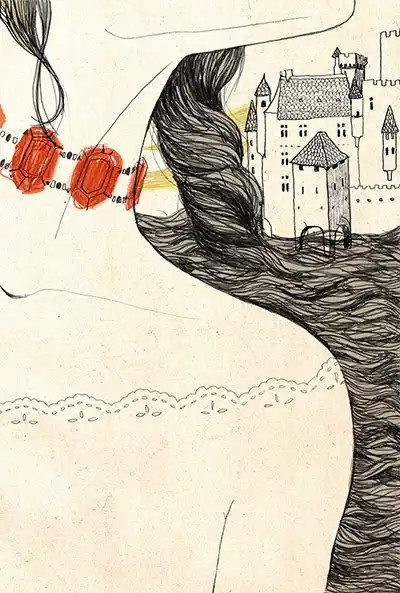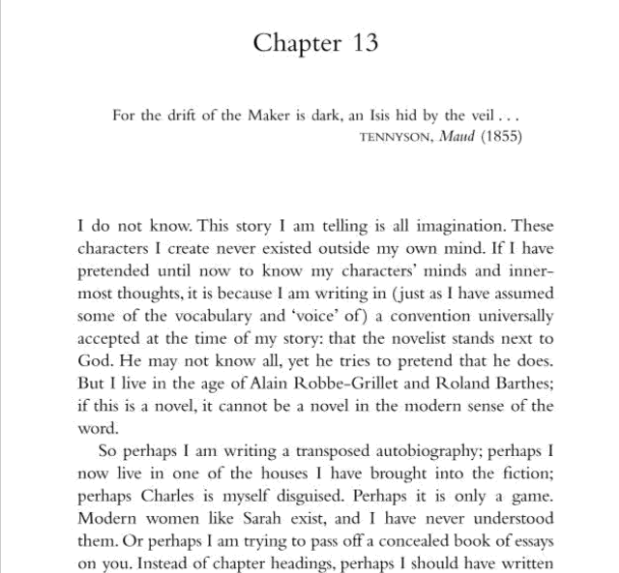Postmodernism
The term "postmodernism" was first used in a philosophical context by French philosopher Jean-François Lyotard in 1979, in The Postmodern Condition: A Report on Knowledge. But, in a literary context, it was between the 1950s and 1960s, after the Second World War, it began being used, in a way to break from modernism.
Postmodernism can be used in multiple contexts: literature, arts, architecture, theater, film, dance, fashion, philosophy, and even commercial art.
Within literature, postmodernism is preceded by modernism, and the latter by realism. Both realism and modernism have a major impact on postmodernism's definition. It is not possible to be defined without the mention of the other two.
According to Linda Hutcheon and Brian McHale, postmodern fiction is not revolutionary. It did, and does, have a major impact in literature, and opened doors and paved ways for countless writings, namely Angela Carter, but it does not do anything that previous fiction hasn't done before. "Postmodernism does not do anything fiction has not done before; it is not innovative." (Bran Nicol - The Cambridge Introduction to Postmodern Fiction, 2009, p. 31)
Postmodern literature questions traditional ideas about reality and the human experience through irony, dark humor, intertextuality and highlighting the ambiguity and ambition inherent in humankind.
Niall Lucy wrote in 1997, in Postmodern Literary Theory: An Introduction, about the usage of the term "postmodernism":
- " (...) postmodern is a term that did not catch on right at the first moment it appeared. Instead, "several neologisms were then in use ('surfiction' and 'fabulation', for example) to describe the 'new' writing", it was the term 'metafiction' that was in vogue. " (p. 82 - 83).
Lucy, N. (1997). Postmodern literary theory: An introduction (pp. 82-83). Blackwell Publishers.
Realism
- Realism attempts to portrait the real word through paintings, images, literature and art. This idea originates from mimesis, which stands for "imitation" in Greek, where the author attempts to replicate reality into a fictional world.
This ideology feeds the belief that realism is capable of "replicating the real world, but has the duty to do so."
Modernist novelists made realism as their main object of critique in the early twentieth century.
Modernism
- Modernist novelists, such as James Joyce and Virginia Woolf, rejected the idea of realism and argued that "subjectivity ought to be rendered more accurately than it was in the 19th century." (Nicol, 2009, p. 19)
- They believed to be impossible to exist one reality only, therefore they granted their characters the ability and freedom to create a reality that applies solely to them.
The 'stream of consciousness' technique plays a significant role in modernists novels because it allows the reader to directly access the characters mind and thoughts, without the author's narration.
Consequently, the narrator's role as "mediator" is forsaken. The reader no longer requires the author's assistance to immerse in the fictional world in presented to them.
Postmodernism doesn't reject this idea, but doesn't necessarily approve it.
Robbe-Grillet
Alain Robbe-Grillet was a French writer and filmmaker who believed,
Description lost its importance. It was no longer used or seen as a crucial part of the understanding of a novel. In the twentieth century description no longer reproduced reality but "had a creative function". "Where 'once it made us see things, now it seems to destroy them'."
Nicol, B. (2009). The Cambridge introduction to postmodern fiction (p. 20). Cambridge University Press.
For Robbe-Grillet, the novel's role isn't to "inform us about reality but to constitute reality." A novel has to create a whole new world, one not imagined before, which does not have any resemblance to the real world.
Robbe-Grillet's perspective emphasizes how the novelist should actively construct rather than transcribing reality. This reflects a postmodernist approach, where the act of storytelling itself is seen as a construct.
"The French Lieutenant's Woman", by John Fowles's, is a great example of a realistic parody which in chapter 13 of his novel, he interrupts his writing by shifting his speech to the reader enlightening them how all the characters above where all from his imagination, how they have never truly been alive, nor lived any of the experiences Fowles previously wrote. They were all from his imagination. With this interruption, his novel, although written in the nineteenth-century, cannot adhere to the traditional novel.
Because modernist novels redefined the parameters of fiction, postmodern fiction developed as a reaction from authors and critics between the middle of the 1950s and the beginning of the 1970s. These authors, who included people like John Fowles, questioned realism's widespread application and expressed skepticism about it.
Postmodernism questions realism's fundamental presumptions, although it does not entirely reject it. While including characteristics of modernism, such as the rejection of excessively detailed descriptions, postmodern fiction also pulls from the ideals and principles of realism. For example, Angela Carter doesn't go into great depth to describe the houses or chamber, in the short-story "Bloody Chamber" in her 1979 book "The Bloody Chamber and Other Stories".
Carter makes reference to the house's coldness and air drafts in "The Lady of the House of Love," although he does it in a broad, nearly cursory manner without going into much depth (quotes can be added for further evidence).
Instead of dismissing realism altogether, postmodern fiction acknowledges its flaws and adopts a nuanced approach to it.
It's crucial to remember that postmodernism is not just an "experimental" genre of writing or the "opposite" of realism. Instead of destroying realism, postmodern authors aimed to reconsider it. Even those who appeared to adhere to more conventional writing styles were reviving previous forms rather than merely replicating them.
The notion that transcription, which represents something outside of the text, can never be entirely correct is central to postmodern writing. Both the writer and the reader encounter an aesthetic version of reality that is distinct from the original as a result of the act of representation. Postmodern literature thus recognizes that the premise of 'exact transcribing', which is essential to realism, is no longer a legitimate one.
Nicol, B. (2009). The Cambridge introduction to postmodern fiction. Cambridge University Press.
Realism in Postmodernism
When the author makes the story compelling enough, readers will accept that what they are reading is "real," which is why realism works. The reader engages in a sort of "game" that includes this notion.
However, postmodernism spoils this "game" by questioning two major ideas in realism:
- "The fictional world it creates exists in its entirety, is analogous to the real world, and that writing is, consequently, "referential"." - In realism, the fictional world is very similar to the real world, consequently, readers will believe in the entirety of the novel as it follows real-world rules. Postmodernism argues that a novel does not have to resemble the real world, nor having to follow its rules.
- "The story it tells is "natural" and "singular", a matter of the narrator simply mediating an "existing" story."" - In realist stories, the narrator/mediator is telling the story, and it often feels as if in a sequence of real life events, the narrator is simply exposing them, and turned it into a novel worth reading. Postmodernism defends the opposite. A story can be inspired in real life events, but they can also be created by the author from scratch and have no "truth" in them.
Nicol, B. (2009). The Cambridge introduction to postmodern fiction. (p.24) Cambridge University Press.
Key Features in Angela Carter's writing:
From a FEMININE PERSPECTIVE:
Angela Carter was a feminist, therefore, in her work, strong female characters, are the main focus, challenging typical gender roles and powerful (male) protagonists. She also grabs this opportunity to rewrite fairy tales and myths into a non-traditional story.
Angela Carter also adapts POSTMODERN TECHNIQUES:
- Intertextuality: By blending other genres, excerpts from other texts, fairytales, folktales and myths, Carter managed to give birth to a whole new narrative in the world of postmodern literature.
- Metafiction: Within her stories, it is evident the self-awareness of the fiction behind the narrative, which is what metafiction stands for. Consequently, it leads the reader to question their understanding on the matter.
- Playfulness and Irony: In Angela Carter's writing, it is often present humor and exaggeration in a way as to critique societal norms and expectations. "The girl burst out laughing; she knew she was nobody's meat." This quotation, from "The Company of the Wolves" (p.149), contradicts the typical victim role. The girl, and main character, was unafraid and showed no fear in front of the wolf.
GENDER, IDENTITY and TRANSFORMATION are also major key feature:
In Wolf Alice, Carter explores how identity is both constructed and deconstructed. Throughout the short-story, we follow the personal growth of the main character, from childhood to adolescence, all on her own. Gender and power are also related to identity, especially since Alice becomes more confident with the passage of time.
Mambrol, N. (2019, April 13). Analysis of Angela Carter's novels. Literary Theory and Criticism. Retrieved from https://literariness.org/2019/04/13/analysis-of-angela-carters-novels/
Angela Carter also critiques patriarchal society, by giving women leading roles and gives voice to women who are heavily objectified, just like in "The Snow Child", the nameless woman who's only role in the short-story was to fulfil a man's needs while his wife, who could not satisfy him, hated her husband's desires that were becoming and transforming into reality before their eyes.
Carter blends genres, such as fantasy, gothic, realism and fairy tales which become a challenge to those who try to decodify her writing. An additional problem is that some of her stories convey realism, in other words, realistic stories, creating it an even bigger struggle to understand which genre she choose for one, or more, short-stories. This is the beauty of Angela Carter's writing. It is so light, yet so heavy. So warm yet, so cold. Can be cold and cruel, with a beautiful ending. Throughout The Bloody Chamber and Other Short Stories we testify all these genres. And we also come across "real" people, such as Dracula and Vlad the Impaler, in Bloody Chamber and The Lady of The House of Love, which makes us question whether the plot is based on true events, or not. All the suspense makes her book and writing thrilling and exciting. Unreliable narrators and unreliable narratives are also crucial features of her stories and postmodernism writing.

